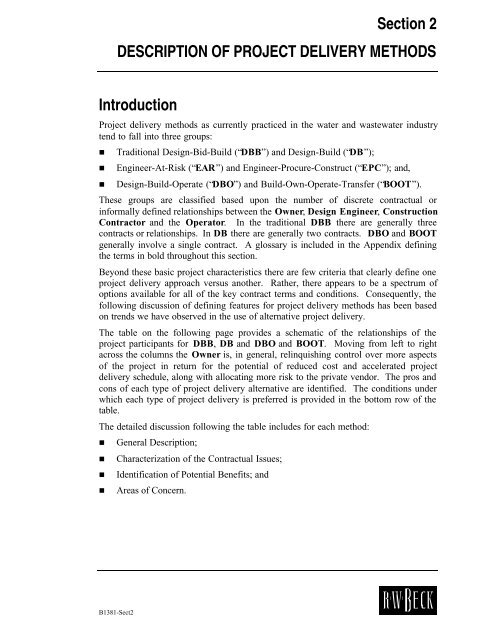Alternative Project Delivery - Texas Water Development Board
Alternative Project Delivery - Texas Water Development Board
Alternative Project Delivery - Texas Water Development Board
Create successful ePaper yourself
Turn your PDF publications into a flip-book with our unique Google optimized e-Paper software.
Section 2<br />
DESCRIPTION OF PROJECT DELIVERY METHODS<br />
Introduction<br />
<strong>Project</strong> delivery methods as currently practiced in the water and wastewater industry<br />
tend to fall into three groups:<br />
• Traditional Design-Bid-Build (“DBB”) and Design-Build (“DB”);<br />
• Engineer-At-Risk (“EAR”) and Engineer-Procure-Construct (“EPC”); and,<br />
• Design-Build-Operate (“DBO”) and Build-Own-Operate-Transfer (“BOOT”).<br />
These groups are classified based upon the number of discrete contractual or<br />
informally defined relationships between the Owner, Design Engineer, Construction<br />
Contractor and the Operator. In the traditional DBB there are generally three<br />
contracts or relationships. In DB there are generally two contracts. DBO and BOOT<br />
generally involve a single contract. A glossary is included in the Appendix defining<br />
the terms in bold throughout this section.<br />
Beyond these basic project characteristics there are few criteria that clearly define one<br />
project delivery approach versus another. Rather, there appears to be a spectrum of<br />
options available for all of the key contract terms and conditions. Consequently, the<br />
following discussion of defining features for project delivery methods has been based<br />
on trends we have observed in the use of alternative project delivery.<br />
The table on the following page provides a schematic of the relationships of the<br />
project participants for DBB, DB and DBO and BOOT. Moving from left to right<br />
across the columns the Owner is, in general, relinquishing control over more aspects<br />
of the project in return for the potential of reduced cost and accelerated project<br />
delivery schedule, along with allocating more risk to the private vendor. The pros and<br />
cons of each type of project delivery alternative are identified. The conditions under<br />
which each type of project delivery is preferred is provided in the bottom row of the<br />
table.<br />
The detailed discussion following the table includes for each method:<br />
• General Description;<br />
• Characterization of the Contractual Issues;<br />
• Identification of Potential Benefits; and<br />
• Areas of Concern.<br />
B1381-Sect2
















